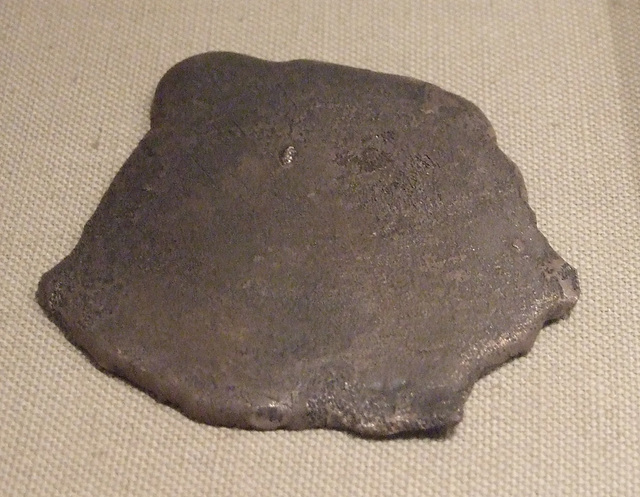Relief Fragment with Three Elamite Heads in the Me…
Double Ointment Vase with 2 Monkeys and a Lid in t…
Procession of Deities Relief in the Metropolitan M…
Detail of the Procession of Deities Relief in the…
Egyptian Diadem with Attached Rams' Heads in the M…
Detail of an Egyptian Diadem with Attached Rams' H…
Sphinx of Amenhotep III in the Metropolitan Museum…
Sphinx of Amenhotep III in the Metropolitan Museum…
Face from a Composite Statue of a Pharaoh in the M…
Maori Gable Figure in the Metropolitan Museum of A…
Icon Triptych and Prayer Book in the Metropolitan…
Detail of an Icon Triptych in the Metropolitan Mus…
Detail of an Icon Triptych in the Metropolitan Mus…
Prayer Book: Harp of Praise in the Metropolitan Mu…
Detail from the Prayer Book: Harp of Praise in the…
Oba with Mudfish Legs Stool in the Metropolitan Mu…
Mask from the Ivory Coast in the Metropolitan Muse…
Ceremonial Sword in the Metropolitan Museum of Art…
Han Dynasty Models in the Metropolitan Museum of A…
Figure of Man Astride a Mythical Beast in the Metr…
Detail of a Standing Tara in the Metropolitan Muse…
Detail of a Standing Tara in the Metropolitan Muse…
Lion Standing on a Pillar Capital in the Metropoli…
Votive Plaque Inscribed with a Sabean Dedication i…
Plaque with a Striding Ram-headed Sphinx Wearing t…
Tondo with Sphinxes and Winged Bulls in the Metrop…
Sumerian Headdress, Necklace, and Hair Ribbons in…
Sumerian Headdress, Necklace, and Hair Ribbons in…
Hair Comb with Inlaid Flowers in the Metropolitan…
Detail of a Bronze Bowl Excavated at Nimrud in the…
Bronze Bowl Excavated at Nimrud in the Metropolita…
Ivory Plaque with Reclining Ram-Headed Sphinxes in…
Detail of the Reliefs on the Piers of the Arch of…
Detail of the Reliefs on the Piers of the Arch of…
Detail of the Reliefs on the Piers of the Arch of…
Detail of the Reliefs on the Piers of the Arch of…
Detail of the Reliefs on the Piers of the Arch of…
Detail of the Reliefs on the Piers of the Arch of…
Detail of the Reliefs on the Piers of the Arch of…
Detail of the Reliefs on the Piers of the Arch of…
Detail of the Reliefs on the Piers of the Arch of…
Detail of the Reliefs on the Piers of the Arch of…
Detail of one of the Relief Panels on the Arch of…
Detail of one of the Relief Panels on the Arch of…
Detail of one of the Relief Panels on the Arch of…
See also...
Keywords
Authorizations, license
-
Visible by: Everyone -
All rights reserved
-
318 visits
Ingot with Hittite Hieroglyphs in the Metropolitan Museum of Art, July 2011


Ingot with Hittite hieroglyphs
Period: Hittite Empire
Date: ca. 14th–13th century B.C.
Geography: Central Anatolia
Culture: Hittite
Medium: Silver
Dimensions: 3.07 x 3.54 in. (7.8 x 8.99 cm)
Classification: Metalwork-Implements-Inscribed
Credit Line: Gift of Norbert Schimmel Trust, 1989
Accession Number: 1989.281.16
Description:
Hittite scribes wrote both in cuneiform script (borrowed from Mesopotamia) and in hieroglyphs, a local development that continued after the end of the Hittite empire into the Neo-Hittite kingdoms. Unfortunately, the hieroglyphs on this silver ingot are not legible, so the writing cannot help us determine the ingot's function.
It has been suggested that the ingot belonged to a silversmith, who might have used it to make or repair jewelry, sculpture, or drinking vessels or other ceremonial containers, such as the stag-headed cup (MMA 1989.281.10) . On the other hand, we know that in the earlier Assyrian Trading Colony period specific weights of Anatolian silver were traded for the goods imported from Assyria. Perhaps this ingot, or pieces from it, were weighed and used as currency in Hittite times, since coins as we know them were only invented in the mid-seventh century B.C.
Text from: www.metmuseum.org/toah/works-of-art/1989.281.16
Period: Hittite Empire
Date: ca. 14th–13th century B.C.
Geography: Central Anatolia
Culture: Hittite
Medium: Silver
Dimensions: 3.07 x 3.54 in. (7.8 x 8.99 cm)
Classification: Metalwork-Implements-Inscribed
Credit Line: Gift of Norbert Schimmel Trust, 1989
Accession Number: 1989.281.16
Description:
Hittite scribes wrote both in cuneiform script (borrowed from Mesopotamia) and in hieroglyphs, a local development that continued after the end of the Hittite empire into the Neo-Hittite kingdoms. Unfortunately, the hieroglyphs on this silver ingot are not legible, so the writing cannot help us determine the ingot's function.
It has been suggested that the ingot belonged to a silversmith, who might have used it to make or repair jewelry, sculpture, or drinking vessels or other ceremonial containers, such as the stag-headed cup (MMA 1989.281.10) . On the other hand, we know that in the earlier Assyrian Trading Colony period specific weights of Anatolian silver were traded for the goods imported from Assyria. Perhaps this ingot, or pieces from it, were weighed and used as currency in Hittite times, since coins as we know them were only invented in the mid-seventh century B.C.
Text from: www.metmuseum.org/toah/works-of-art/1989.281.16
- Keyboard shortcuts:
Jump to top
RSS feed- Latest comments - Subscribe to the comment feeds of this photo
- ipernity © 2007-2024
- Help & Contact
|
Club news
|
About ipernity
|
History |
ipernity Club & Prices |
Guide of good conduct
Donate | Group guidelines | Privacy policy | Terms of use | Statutes | In memoria -
Facebook
Twitter

Sign-in to write a comment.